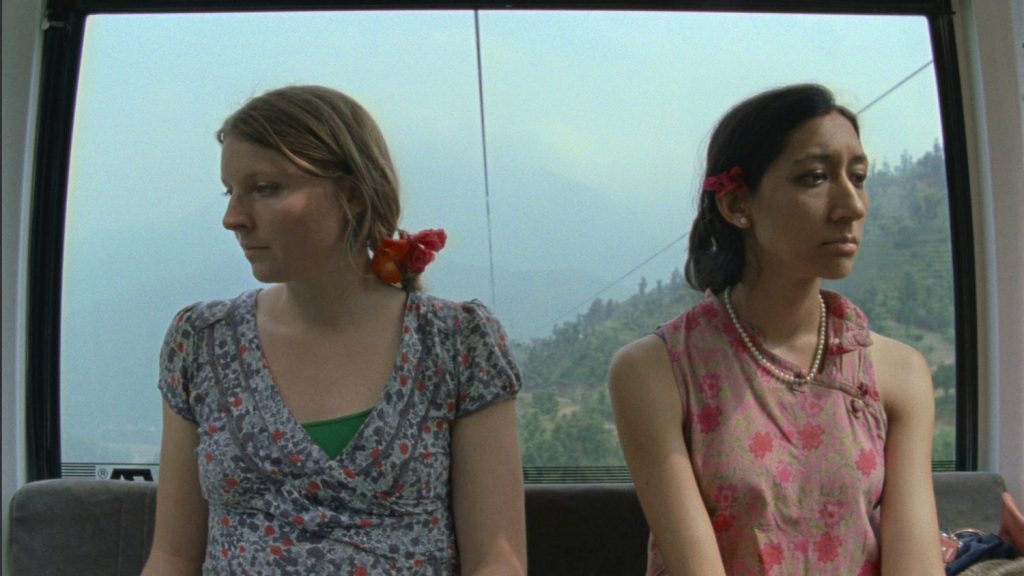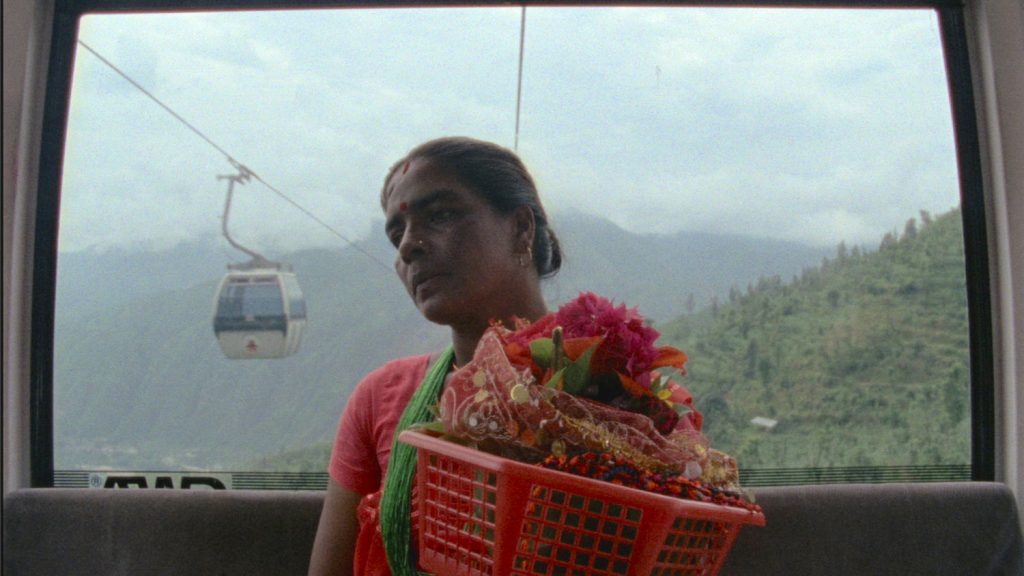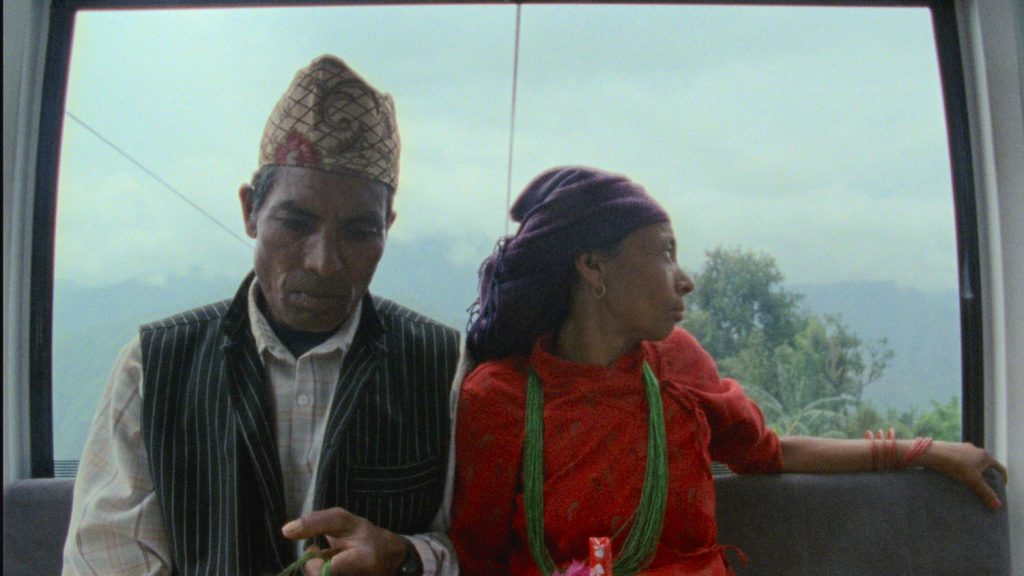At the end of a nearly three-kilometer cable car journey in Nepal is the temple of the Goddess Bhagwati. The journey takes approximately ten minutes to complete. Each year, thousands of Hindus participate in the Manakamana Darshan, a pilgrimage to the temple to worship the Goddess and to have their wishes granted.
On the surface, a film documenting this expedition could be rather tedious. But Manakamana filmmakers Stephanie Spray and Pacho Velez have crafted a fascinating, observational film that far exceeds expectations (shot on the same 16mm camera that Robert Gardner used for his remarkable Forest of Bliss). The resulting work, recently featured in the Film Society of Lincoln Center’s “Art of the Real” series, opens Friday, 18-April, at the IFC Center in New York.
Spray and Velez spoke with Fandor co-founder Jonathan Marlow at the Ann Arbor Film Festival in late-March. This is the first of a two-part discussion.
Jonathan Marlow: As we discussed at dinner yesterday, this recording is just for transcription purposes.
Stephanie Spray: It’s not verbatim.
Marlow: Correct. Everything that you will say here will seem much more interesting in-print than it really was.
Spray: [laughs] That’s good.
Pacho Velez: That’s what we always aim for.
Marlow: That’s reassuring. We [Jonathan and Pacho] first discussed the notion of talking when we met in Rotterdam. That is where I was first able to see Manakamana since I kept missing it everywhere else. Fortunately, you have a great ‘home’ with Cinema Guild. Thanks to our relationship with them, we have Leviathan and Lucien [Castaing-Taylor]‘s earlier film…
Spray: Sweetgrass, yes. I noticed that.
Marlow: So it could be said that we already have an interest in the work coming out of [Harvard University’s] Sensory Ethnography Lab. This effort to encourage otherwise unrelated folks to collaborate on projects, for instance, is somewhat unique to that institution.
Spray: Which isn’t always the case, though. But it seems like there is a productive model before we worked together. Foreign Parts by J.P. [Sniadecki] and Véréna [Paravel] was really successful at the time. Of course, Lucian with Ilisa [Barbash], but they were a couple. That is a little bit different. The notion of the Sensory Ethnography Lab is a bit confusing because there is also a class called ‘Sensory Ethnography.’ The first few years, everyone was working independently on their own projects. It is exhausting to work on your own film from beginning to end. You come up with a concept, you shoot it, you edit; you do everything. Later, in the class, they started encouraging students to work in pairs. That was the start, in the class model and in the lab. People started to collaborate more and more. One person would shoot and someone else would edit in the class.
Marlow: Is the pairing generally folks from different disciplines?
Spray: In the class? They’re not doing it now. But they were during the three years we were there. [It was dependent on] whoever was in the class. Anthropologists, undergraduate filmmakers… There were all kinds of people in the class.
Velez: It is even more complicated than this because I’m not actually inside of it in any formal way.
Spray: Right. It is a strange…
Velez: Before Manakamana I’d made three films, collaboratively, two of which were with an anthropology grad student [Maple Razsa]. There’s a way that this work was also going on at Harvard, before…
Marlow: …it was formalized?
Velez: Yes. Also, Robert Gardner often worked in collaboration with other people. There was almost always a number of collaborators on his films.
Spray: What was the name of the person who worked with him on Forest of Bliss?
Velez: Ákos Östör. He is also a filmmaker.
Marlow: Right.
Velez: It is strange because (though it is a collaboration) it also means that both parties are doing considerably more work than a director does on a traditional film. A director generally has an editor, a camera person, a sound person and all of these different roles are filled by different people. This is just a different way of dividing the labor. It is like slicing it down the middle.
Spray: Even more than the collaboration, in addition to this nebulous entity of the Lab there is a community of people that supports this work. There are the people in the VES [Visual and Environmental Studies] department. You have crit sessions and most of ours were in the Film Study Center (which was founded by Robert Gardner). Institutionally, it is complicated but, if you look at the people, there are all these intersections. Not only were we collaborating but we had plenty of feedback. From Lucien, as well. He later said, ‘I’d be happy to sign-on as a way to support your film and be a producer.’ And then Véréna became a producer. They both said, ‘We’re not really producers but we hope to support your film.’ It was more promotional…
Marlow: They’re not producers and you’re not really directors. Is that what you’re saying?
Spray: [Laughs.] I don’t know. We’re all filmmakers. These titles don’t always fit neatly in the Lab…
Velez: Much of what we are pointing to is that the associations in the Lab (and even ‘membership’ in the Lab) are really informal quantities in many ways.
Marlow: There is no secret handshake or anything like that.
Velez: Right. That is important. Many people ask me, ‘How do I join the Lab?’ I answer, ‘You have to go and become an anthropology student or you have to become a VES student. Then you have to do this and do that. Then, two or three years down the line, if you’re making films and Lucien is interested in your work, then maybe…’ And they say, ‘What? (Viagra) There isn’t a form you can fill out?’ ‘No, it doesn’t work like that.’
Marlow: It is not formalized.
Spray: Many people think that it is like a production house type thing, “from the Sensory Ethnography Lab.” If you think about it, the bar-for-entrance is so high… You already have to be enrolled in some program at Harvard as an undergrad.
Marlow: Are you trying to say that it is somewhat competitive? [Laughs.]
Spray: But it is ridiculous. It is a very closed community in many ways. A lot of people are graduate students. Maybe they’re in anthropology but maybe they’re not. I think that Lucien and Véréna are thinking more about… Right now, it has a home at Harvard. It probably will stay at Harvard but, because of how exclusive it is, I don’t know if they would want to open it up in any way. There is something wonderful about having this academic environment and the classes. The way that you can circumvent this is because of visiting filmmakers (who come in and out). People show work at the Film Study Center and participate in other ways. That opens the community up. Otherwise, it would be really insular. It is like all these bright people sitting around, watching a movie and suggesting cuts.
Marlow: Hanging out at Harvard Film Archive.
Spray: The Film Archive! That is a major…
Velez: …also, for us, it makes sense to talk a little bit about CalArts, too. I studied there. [After we finished Manakamana] I sent the screener to Thom Andersen he said, ‘Ah, Pachi, you finally made a CalArts film.’ Of course, you [Stephanie] were studying with Rebecca Barron during this time.
Spray: I did for a semester. She taught. From Velez’s end, it makes more sense to think of CalArts. I have never been there and I don’t know much about it.
Marlow: But you were also both watching James Benning…
Spray: Oh, yes. That is for certain.
Marlow: There is definitely a Benning-esque component. The rigor of the timing of what you see and that the duration of each sequence is timed to the duration of the ride. In that way, seeing it for the first time, it definitely felt as if there was a CalArts connection. Even if there isn’t. In any event, it always surprises me (both during the Q&A at Rotterdam and the Q&A here [at AAFF] last night) that someone inevitably asks, ‘Do the passengers recognize that they were being filmed?’ Which, to me, is somewhat absurd. How would they not know that they were being filmed? I guess if you’ve never been in a cable car it would be difficult to realize that there would be no way to obscure the camera.
Spray: Unless it was a surveillance lens. People do not have an understanding.
[To be continued.]







